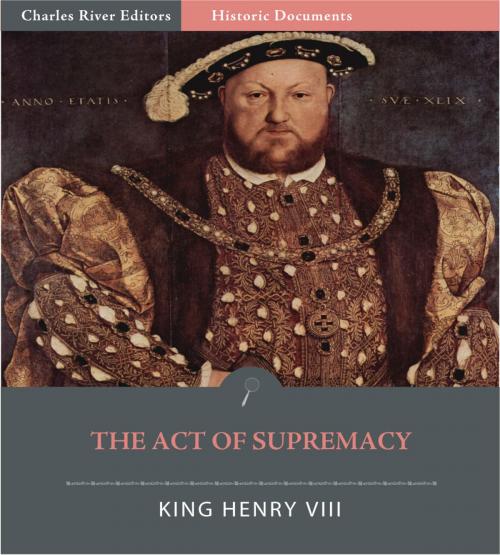The 1534 Act of Supremacy
Nonfiction, Religion & Spirituality, Christianity, Church, Church History, History, British| Author: | King Henry VIII | ISBN: | 9781475305289 |
| Publisher: | Charles River Editors | Publication: | April 12, 2012 |
| Imprint: | Language: | English |
| Author: | King Henry VIII |
| ISBN: | 9781475305289 |
| Publisher: | Charles River Editors |
| Publication: | April 12, 2012 |
| Imprint: | |
| Language: | English |
With just one paragraph, Englands King Henry VIII changed the course of the Catholic Churchs history. The Act of Supremacy of November 1534 (26 Hen. 8 c. 1) was an Act of the Parliament of England under King Henry VIII declaring that he was "the only supreme head on earth of the Church in England" and that the English crown shall enjoy "all honours, dignities, preeminences, jurisdictions, privileges, authorities, immunities, profits, and commodities to the said dignity." By the wording of the Act, it was made clear that Parliament was not granting the King the title (thereby suggesting that they had the right to later withdraw them) but rather it was stated as a recognized fact. In the Act of Supremacy, Henry abandoned Rome completely. He then went on to found a new church called Ecclesia Anglicana. He appointed himself and his successors as the supreme rulers of this new church. Henry had been declared "Defender of the Faith" (Fidei Defensor) in 1521 by Pope Leo X for his pamphlet accusing Martin Luther of heresy. Parliament later conferred this title upon Henry in 1544. The 1534 Act made official the English Reformation that had been brewing since 1527. The main purpose of this act was so that Henry could get an annulment of his marriage to Catherine of Aragon, because Henry had fallen in love with Anne Boleyn. However, Pope Clement VII still refused to grant the annulment, due to the familial relations Catherine had with the Holy Roman Emperor at the time. The Treasons Act was later issued saying that to disavow the Act of Supremacy and to deprive the King of his "dignity, title, or name" was to be considered treason.
With just one paragraph, Englands King Henry VIII changed the course of the Catholic Churchs history. The Act of Supremacy of November 1534 (26 Hen. 8 c. 1) was an Act of the Parliament of England under King Henry VIII declaring that he was "the only supreme head on earth of the Church in England" and that the English crown shall enjoy "all honours, dignities, preeminences, jurisdictions, privileges, authorities, immunities, profits, and commodities to the said dignity." By the wording of the Act, it was made clear that Parliament was not granting the King the title (thereby suggesting that they had the right to later withdraw them) but rather it was stated as a recognized fact. In the Act of Supremacy, Henry abandoned Rome completely. He then went on to found a new church called Ecclesia Anglicana. He appointed himself and his successors as the supreme rulers of this new church. Henry had been declared "Defender of the Faith" (Fidei Defensor) in 1521 by Pope Leo X for his pamphlet accusing Martin Luther of heresy. Parliament later conferred this title upon Henry in 1544. The 1534 Act made official the English Reformation that had been brewing since 1527. The main purpose of this act was so that Henry could get an annulment of his marriage to Catherine of Aragon, because Henry had fallen in love with Anne Boleyn. However, Pope Clement VII still refused to grant the annulment, due to the familial relations Catherine had with the Holy Roman Emperor at the time. The Treasons Act was later issued saying that to disavow the Act of Supremacy and to deprive the King of his "dignity, title, or name" was to be considered treason.















